The Bay Trail Preview: Intel Atom Z3770 Tested
by Anand Lal Shimpi & Brian Klug on September 11, 2013 12:00 PM EST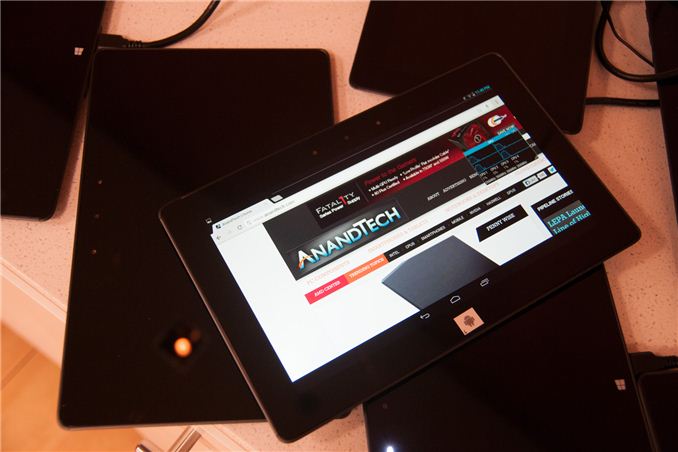
Earlier this year Intel unveiled Silvermont, its first true architectural update to Atom since its introduction in 2008. I won’t rehash Silvermont’s architecture here, but it’s designed to be a true test of Intel’s performance in the ultra mobile space. Leveraging Intel’s first 22nm SoC process and a very low power/efficient microarchitecture, Silvermont aims squarely at the latest Krait cores from Qualcomm and ARM’s Cortex A15.
Today Intel takes the next step forward, introducing the first tablet SoC based on Silvermont: Bay Trail.
Bay Trail takes up to four Silvermont cores, and for the first time in an ultra mobile Intel SoC pairs them with Intel’s own graphics IP. That’s right, rather than using a GPU block from Imagination Technologies, Bay Trail leverages the same GPU architecture as Ivy Bridge.
The first Bay Trail tablets will be shipping by the end of the year, across both Android and Windows 8.1. Intel expects Bay Trail to show up in tablets and 2-in-1s priced below $599, with everything above $599 falling under Haswell’s jurisdiction.
Bay Trail & Branding
Bay Trail, like all Atom platforms before it, will be available in multiple form factors. Unlike the Atoms of yesterday however, the SoC will carry Pentium and Celeron branding when used in notebooks and desktops. Intel didn’t disclose too much about its Silvermont plans in other form factors other than some basic naming:
Basically notebooks ship under the Pentium N3000 & Celeron N2000 series, while desktops will carry Pentium J2000 & Celeron J1000 branding. All Pentium SKUs seem to be quad-core, while Celeron SKUs will be available in both dual and quad-core versions.
Thankfully Intel shied away from introducing the same complexity with its tablet focused Bay Trail parts. All Bay Trail tablet SKUs carry Atom branding. There’s the quad-core Z3700 series and the dual-core Z3600 series.
Although Intel offers both dual and quad-core Bay Trail SKUs, they are both based on the same single physical design. In other words, dual-core Bay Trail parts are just die harvested quad-core parts. Intel isn’t disclosing die size or transistor counts, which is ironic (and disappointing) given that Apple just disclosed both (or at least relative magnitude of one) for its A7 SoC.
Internally, the Bay Trail design is pretty nice. There are either two or four cores enabled, each pair with a shared 1MB L2 cache (2MB total for a quad-core part). Intel is following the unfortunate lead of everyone else in the mobile industry and advertising max turbo frequencies exclusively.
Thankfully Intel hasn’t yet decided to obfuscate max non-turbo frequencies:
| Bay Trail Turbo Speeds | ||||||||
| Z3770 | Z3770D | Z3740 | Z3740D | Z3680 | Z3680D | |||
| Max turbo frequency | 2.39GHz | 2.41GHz | 1.86GHz | 1.83GHz | 2.0GHz | 2.0GHz | ||
| Max non-turbo Frequency | 1.46GHz | 1.5GHz | 1.33GHz | 1.33GHz | 1.33GHz | 1.33GHz | ||
In general you’re looking at 1.33GHz - 1.46GHz max non-turbo frequencies, with Bay Trail being able to turbo up to anywhere between 1.83GHz and 2.40GHz depending on SKU.
Although the core architecture is 64-bit in design, there will be no OS support for 64-bit Bay Trail at launch. Windows 8.1 with Connected Standby appears to still be 32-bit only, and obviously Android is 32-bit only at this point as well.
The memory interface is fairly ridiculous by mobile standards. You either get two 64-bit LPDDR3 channels (128-bit total width) or a single 64-bit DDR3L channel. In the case of the former, that’s the same memory bus width as Apple’s A5X/A6X line of SoCs as well as the standard Core i3/i5/i7 parts. Max supported memory frequency is 1066MHz in dual-channel LPDDR3 mode, or 1333MHz in single-channel DDR3L mode. The only benefit to the latter is really cost, as Bay Trail will purportedly show up in some very cheap devices.
The GPU is Intel’s own Gen7 graphics core, a cut down implementation of what we first saw in Ivy Bridge. I suppose it’s premature to expect Merrifield, Bay Trail’s smartphone counterpart, to also use Intel’s own graphics core but it’s clear this is the direction Intel is headed in - and away from licensing IP from Imagination Technologies.
Rather than 16 EUs in the Ivy Bridge GT2 configuration (HD 4000), Bay Trail’s HD Graphics core ships with 4. The 4 EUs are otherwise effectively identical to what we found in Ivy Bridge. The GPU can dynamically scale frequency and share power between itself and the CPU cores. Minimum GPU frequency on Bay Trail is 311MHz and a max GPU frequency of 667MHz (or 688MHz for the DDR3L SKUs).
Intel is quick to point out that Bay Trail’s GPU supports DirectX 11 and OpenGL ES 3.0. Unfortunately this support list appears limited to Windows. Under Android, it’s unclear whether or not Bay Trail will ship with anything above OpenGL ES 2.0 support. The same goes for GPU accelerated Renderscript. Bay Trail supports up to 2560 x 1440 displays over eDP1.3/DP1.2, or 1080p over HDMI. Panel Self Refresh is also supported.
Video encode and decode blocks also shifted away from Imagination in Bay Trail. Both IP blocks are custom from Intel now. The ISP (Image Signal Processor) is from Silicon Hive (an Intel acquisition).


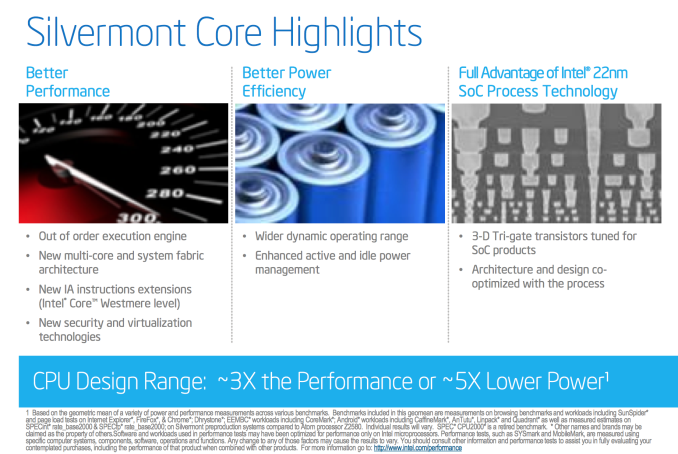
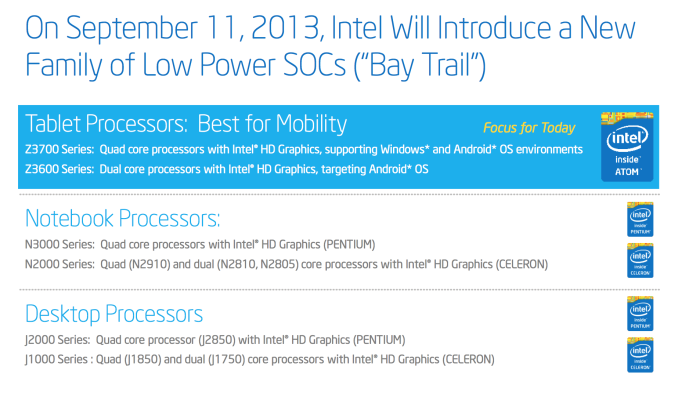
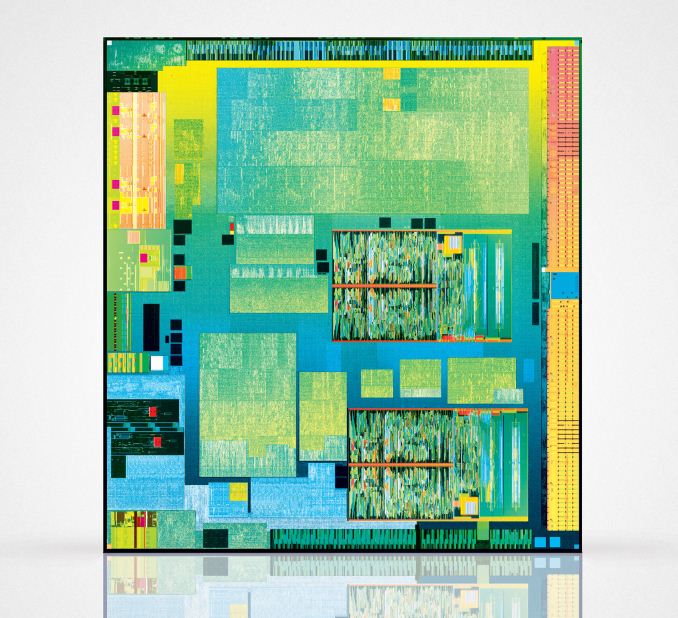
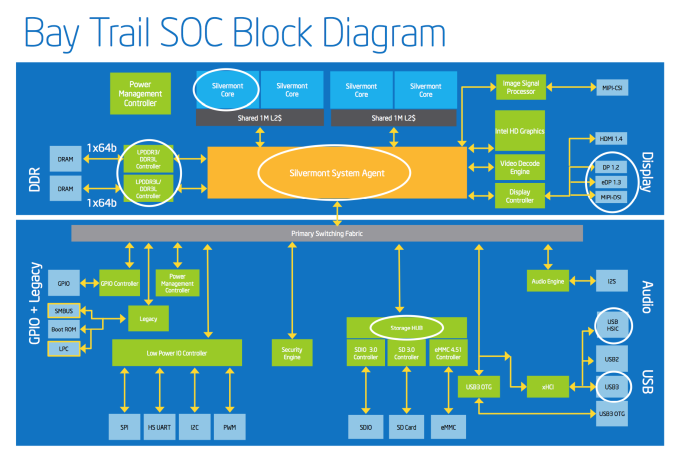
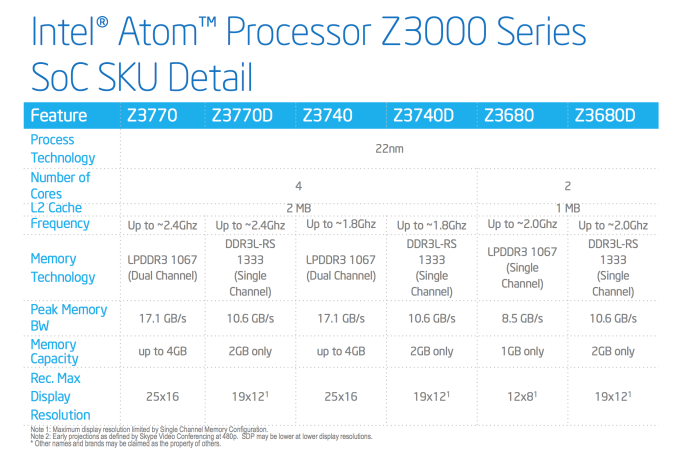
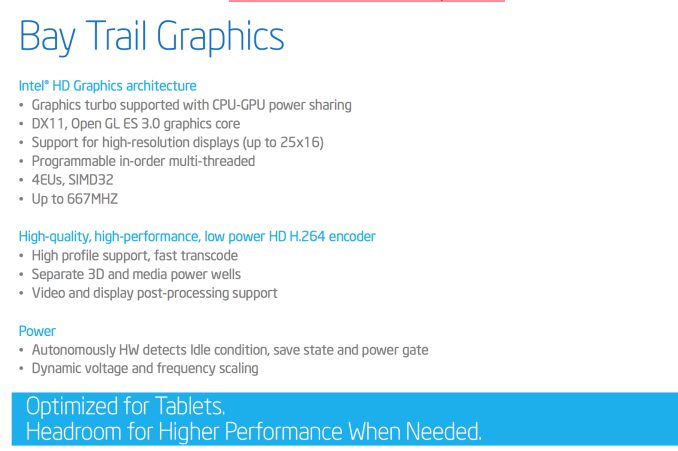
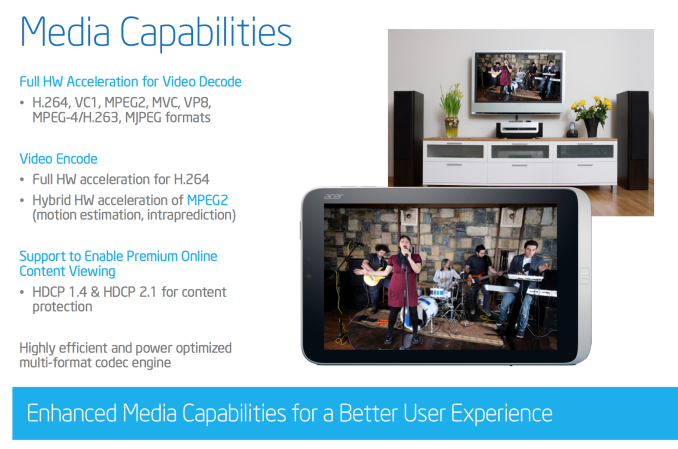








190 Comments
View All Comments
JumpingJack - Thursday, September 12, 2013 - link
Nope, power consumption would still be too high, AMD has nothing that can really match up in this space. This has been true with Kabini and all prior iterations. This is why there is so few design wins. AMD has a power consumption problem (just as Intel did a few years back).silverblue - Thursday, September 12, 2013 - link
Perhaps, but the GPU looks to be overkill for the CPU power on offer.Jaguar appears to lack the sort of dynamic L2 power gating we will be seeing with Steamroller which would make sense in low-power situations. Also, it's still a dual-issue front end - highlighted as a possible decent boost to performance. We don't actually know this particular detail as regards Bay Trail; it could very well be dual-issue as well.
monstercameron - Friday, September 13, 2013 - link
not so sure about that bobcat sold fairly well. Also if amd optimized the a4-5000 for tablet scenarios then the power consumption would be closer to atom. notebookcheck reviewed the a4-5000 in the acer e1-522 http://www.notebookcheck.net/Review-Acer-Aspire-E1... and there web browsing test reached 3:47 hours on a 37Wh battery [equating to a ~10W draw with laptop components]iwod - Thursday, September 12, 2013 - link
A Few things,Browser Performance, or JavaScript performance are heavily influenced by its VM. And the version it used to test. Not mention these VM has the best tuning on x86 for years. And Safari JS's VM JvascriptCore isn't very optimized for Karken. As shown in www.arewefastyet.com
And i dont argee much the conclusion. While others has been siting Anand as an Pro Intel site. I have often disagree with it. But looking at those results I dont see how on the CPU side is winning anything. At least not against Shield or the upcoming Qualcomm MSM. As i have said the Javascript Benchmarks are not a reliable way to look at it. And all other CPU based performance Intel is either behind or on par. Not winning the benchmarks. So No, the CPU isn't the best performance here.
And on GPU, it concluded with " Intel's HD graphics in Bay Trail appear to be similar in performance to the PowerVR SGX 554MP4 in the iPad 4" I mean unless you are interpreting the results much more differently then what i read i the graph. Then please do explain yourself there. Because I dont read how it is "similar". There are like at least 20% of performance difference.
And if you want to compare with the best of ARM SoC breed coming up in the same time frame ( And actually shipping it )? Wait until Apple announce its A7X coming in the next iPad.
If I may have missed something you explained. Please enlighten me. Otherwise this is a review that is quite pro Intel.
fteoath64 - Thursday, September 12, 2013 - link
"And if you want to compare with the best of ARM SoC breed coming up in the same time frame ( And actually shipping it )? Wait until Apple announce its A7X coming in the next iPad."Yeah, the A7X is going to look like 50% ahead of Intel HD gpu and will lead the SoC market ingpu performance for the next 2 years AGAIN!.
Krysto - Thursday, September 12, 2013 - link
50%? Snapdragon 800 and Tegra 4 are already up to 80 percent faster in some GPU tests. A7X will be 150% faster, if Apple doubles the GPU performance from last year again.Once again Anandtech shows its bias for Intel, when it's saying Bay Trail is even "competitive" with what is/will be available in the same timeframe.
formulav8 - Thursday, September 12, 2013 - link
You know, I have defended Anand before with people claiming such things, but I can somewhat see what some people mean. Thankfully I rarely come here for any of his stuff, just mainly come to the site for the forums these days.andrewaggb - Friday, September 13, 2013 - link
yeah that's what I see happening as well. I'm seriously considering getting a T100 anyways because it's pretty good value for a windows device... but as good as bay trail is, it's going to be slower than the A7X by a large margin. I think intel aimed too low.Jaybus - Monday, September 16, 2013 - link
I disagree. GPU performance is not the end-all of tablet performance criteria. They can all do 2D fast enough. For everything but games, if it can play video streams smoothly, then it's fast enough. Overall snappiness and responsiveness is more a CPU thing. So, if the power usage is as claimed, then saying that the Intel chip is a contender in the tablet market is more than fair. I don't see how it is bias toward Intel if it is just the simple truth.monstercameron - Friday, September 13, 2013 - link
temash a4-1350 might have it beat.